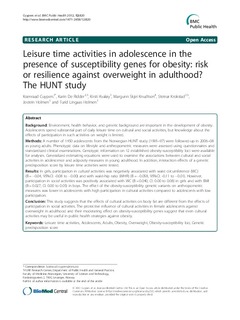| dc.contributor.author | Cuypers, Koenraad | |
| dc.contributor.author | De Ridder, Karin | |
| dc.contributor.author | Kvaløy, Kirsti | |
| dc.contributor.author | Knudtsen, Margunn Skjei | |
| dc.contributor.author | Krokstad, Steinar | |
| dc.contributor.author | Holmen, Jostein | |
| dc.contributor.author | Holmen, Turid Lingaas | |
| dc.date.accessioned | 2015-09-11T12:33:15Z | |
| dc.date.accessioned | 2015-09-29T13:38:40Z | |
| dc.date.available | 2015-09-11T12:33:15Z | |
| dc.date.available | 2015-09-29T13:38:40Z | |
| dc.date.issued | 2012 | |
| dc.identifier.citation | BMC Public Health 2012, 12:820 | nb_NO |
| dc.identifier.issn | 1471-2458 | |
| dc.identifier.uri | http://hdl.handle.net/11250/428957 | |
| dc.description.abstract | Background: Environment, health behavior, and genetic background are important in the development of obesity.
Adolescents spend substantial part of daily leisure time on cultural and social activities, but knowledge about the
effects of participation in such activities on weight is limited.
Methods: A number of 1450 adolescents from the Norwegian HUNT study (1995–97) were followed-up in 2006–08
as young adults. Phenotypic data on lifestyle and anthropometric measures were assessed using questionnaires and
standardized clinical examinations. Genotypic information on 12 established obesity-susceptibility loci were available
for analyses. Generalized estimating equations were used to examine the associations between cultural and social
activities in adolescence and adiposity measures in young adulthood. In addition, interaction effects of a genetic
predisposition score by leisure time activities were tested.
Results: In girls, participation in cultural activities was negatively associated with waist circumference (WC)
(B = −0.04, 95%CI: -0.08 to −0.00) and with waist-hip ratio (WHR) (B = −0.058, 95%CI: -0.11 to −0.01). However,
participation in social activities was positively associated with WC (B = 0.040, CI: 0.00 to 0.08) in girls and with BMI
(B = 0.027, CI: 0.00 to 0.05) in boys. The effect of the obesity-susceptibility genetic variants on anthropometric
measures was lower in adolescents with high participation in cultural activities compared to adolescents with low
participation.
Conclusion: This study suggests that the effects of cultural activities on body fat are different from the effects of
participation in social activities. The protective influence of cultural activities in female adolescents against
overweight in adulthood and their moderating effect on obesity-susceptibility genes suggest that even cultural
activities may be useful in public health strategies against obesity. | nb_NO |
| dc.language.iso | eng | nb_NO |
| dc.publisher | BioMed Central | nb_NO |
| dc.title | Leisure time activities in adolescence in the presence of susceptibility genes for obesity: risk or resilience against overweight in adulthood? The HUNT study | nb_NO |
| dc.type | Journal article | nb_NO |
| dc.type | Peer reviewed | en_GB |
| dc.date.updated | 2015-09-11T12:33:15Z | |
| dc.source.volume | 12 | nb_NO |
| dc.source.journal | BMC Public Health | nb_NO |
| dc.identifier.doi | 10.1186/1471-2458-12-820 | |
| dc.identifier.cristin | 964407 | |
| dc.description.localcode | © 2012 Cuypers et al.; licensee BioMed Central Ltd. This is an Open Access article distributed under the terms of the Creative Commons Attribution License (http://creativecommons.org/licenses/by/2.0), which permits unrestricted use, distribution, and reproduction in any medium, provided the original work is properly cited. | nb_NO |
